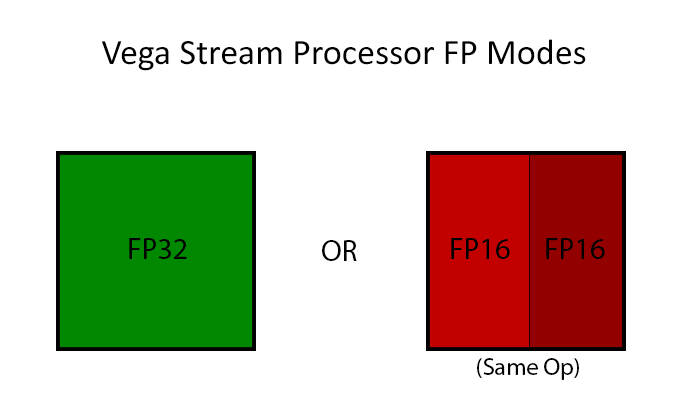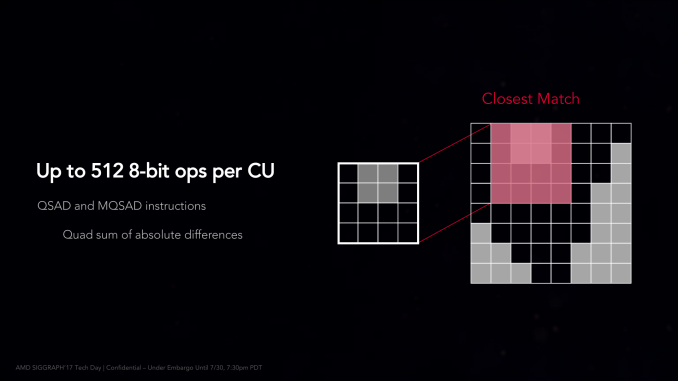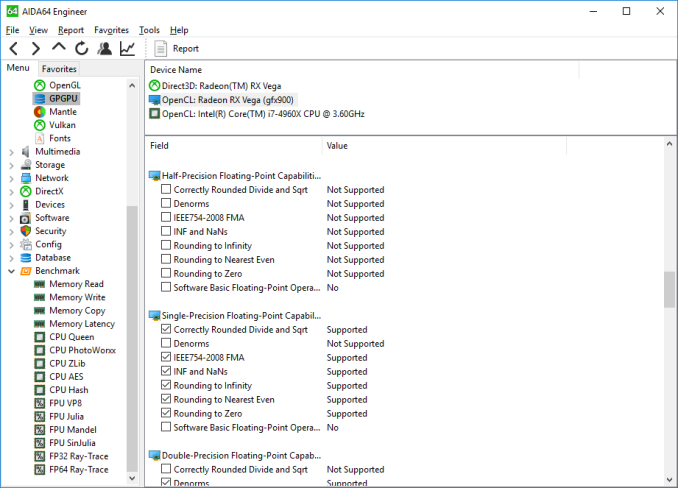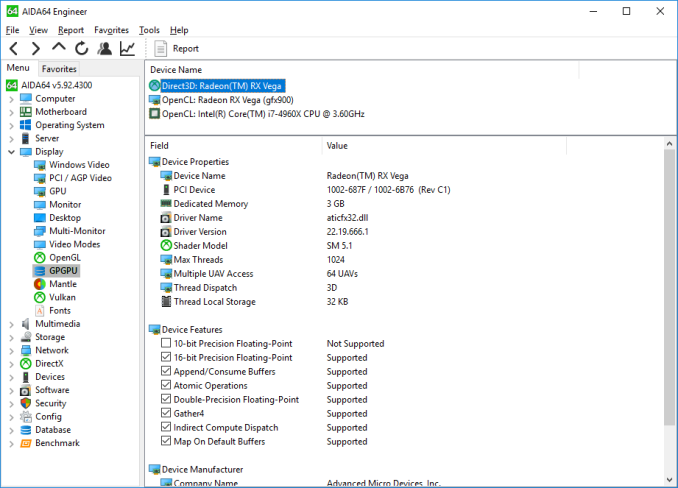The AMD Radeon RX Vega 64 & RX Vega 56 Review: Vega Burning Bright
by Ryan Smith & Nate Oh on August 14, 2017 9:00 AM ESTRapid Packed Math: Fast FP16 Comes to Consumer Cards (& INT16 Too!)
Arguably AMD’s marquee feature from a compute standpoint for Vega is Rapid Packed Math. Which is AMD’s name for packing two FP16 operations inside of a single FP32 operation in a vec2 style. This is similar to what NVIDIA has done with their high-end Pascal GP100 GPU (and Tegra X1 SoC), which allows for potentially massive improvements in FP16 throughput. If a pair of instructions are compatible – and by compatible, vendors usually mean instruction-type identical – then those instructions can be packed together on a single FP32 ALU, increasing the number of lower-precision operations that can be performed in a single clock cycle. This is an extension of AMD’s FP16 support in GCN 3 & GCN 4, where the company supported FP16 data types for the memory/register space savings, but FP16 operations themselves were processed no faster than FP32 operations.
The purpose of integrating fast FP16 and INT16 math is all about power efficiency. Processing data at a higher precision than is necessary unnecessarily burns power, as the extra work required for the increased precision accomplishes nothing of value. In this respect fast FP16 math is another step in GPU designs becoming increasingly min-maxed; the ceiling for GPU performance is power consumption, so the more energy efficient a GPU can be, the more performant it can be.
Taking advantage of this feature, in turn, requires several things. It requires API support and it requires compiler support, but above all it requires code that explicitly asks for FP16 data types. The reason why that matters is two-fold: virtually no existing programs use FP16s, and not everything that is FP32 is suitable for FP16. In the compute world especially, precisions are picked for a reason, and compute users can be quite fussy on the matter. Which is why fast FP64-capable GPUs are a whole market unto themselves. That said, there are whole categories of compute tasks where the high precision isn’t necessary; deep learning is the poster child right now, and for Vega Instinct AMD is practically banking on it.
As for gaming, the situation is more complex still. While FP16 operations can be used for games (and in fact are somewhat common in the mobile space), in the PC space they are virtually never used. When PC GPUs made the jump to unified shaders in 2006/2007, the decision was made to do everything at FP32 since that’s what vertex shaders typically required to begin with, and it’s only recently that anyone has bothered to look back. So while there is some long-term potential here for Vega’s fast FP16 math to become relevant for gaming, at the moment it doesn’t do much outside of a couple of benchmarks and some AMD developer relations enhanced software. Vega will, for the present, live and die in the gaming space primarily based on its FP32 performance.
The biggest obstacle for AMD here in the long-term is in fact NVIDIA. NVIDIA also supports native FP16 operations, however unlike AMD, they restrict it to their dedicated compute GPUs (GP100 & GV100). GP104, by comparison, offers a painful 1/64th native FP16 rate, making it just useful enough for compatibility/development purposes, but not fast enough for real-world use. So for AMD there’s a real risk of developers not bothering with FP16 support when 70% of all GPUs sold similarly don’t support it. It will be an uphill battle, but one that can significantly improve AMD’s performance if they can win it, and even more so if NVIDIA chooses not to budge on their position.
Though overall it’s important to keep in mind here that even in the best case scenario, only some operations in a game are suitable for FP16. So while FP16 execution is twice as fast as FP32 execution on paper specifically for a compute task, the percentage of such calculations in a game will be lower. In AMD’s own slide deck, they illustrate this, pointing out that using 16-bit functions makes specific rendering steps of 3DMark Serra 20-25% faster, and those are just parts of a whole.
Moving on, AMD is also offering limited native 8-bit support via a pair of specific instructions. On Vega the Quad Sum of Absolute Differences (QSAD) and its masked variant can be executed on Vega in a highly packed form using 8-bit integers. SADs are a rather common image processing operation, and are particularly relevant for AMD’s Instinct efforts since they are used in image recognition (a major deep learning task).
Finally, let’s talk about API support for FP16 operations. The situation isn’t crystal-clear across the board, but for certain types of programs, it’s possible to use native FP16 operations right now.
Surprisingly, native FP16 operations are not currently exposed to OpenCL, according to AIDA64. So within a traditional AMD compute context, it doesn’t appear to be possible to use them. This obviously is not planned to remain this way, and while AMD hasn’t been able to offer more details by press time, I expect that they’ll expose FP16 operations under OpenCL (and ROCm) soon enough.
Meanwhile, High Level Shader Model 5.x, which is used in DirectX 11 and 12, does support native FP16 operations. And so does Vulkan, for that matter. So it is possible to use FP16 right now, even in games. Running SiSoftware’s Sandra GP GPU benchmark with a DX compute shader shows a clear performance advantage, albeit not a complete 2x advantage, with the switch to FP16 improving compute throughput by 70%.
However based on some other testing, I suspect that native FP16 support may only be enabled/working for compute shaders at this time, and not for pixel shaders. In which case AMD may still have some work to do. But for developers, the message is clear: you can take advantage of fast FP16 performance today.
















213 Comments
View All Comments
Makaveli - Monday, August 14, 2017 - link
https://www.newegg.ca/Product/ProductList.aspx?Sub...Air cooled Vega 64 for $839 CAD I don't think so.
When you can pay $659 CAD for the 1080?
I prefer AMD cards over NV but even I'm not dumb enough to do this.
$180 extra for the same performance and must higher heat output.
mapesdhs - Monday, August 14, 2017 - link
That was exactly my point, real pricing is way out of whack for the Vega64 to make any sense atm. Can you check, is it possible to buy a 1080 Ti for the same price as the cheapest Vega64/Liquid? This is the case in the UK, where the 64/Liquid is basically 700 UKP, same as a Palit Jetstream 1080 Ti.Makaveli - Monday, August 14, 2017 - link
@mapesdhsLiquid Vega 64 is $979 CAD
1080 TI air is in the $924-$984 CAD.
Liquid 1080 Ti's are in the $1,014-$1,099 range.
And the 1080 Ti will still be faster and using less power....
zodiacfml - Monday, August 14, 2017 - link
AMD is truly an underdog. Fighting Nvidia and Intel at the same time but I could see that they are doing their best based on their designs. Their unique position is what made them successful in gaming consoles. Can't wait to see the performance of Raven Ridge parts.Frenetic Pony - Monday, August 14, 2017 - link
Regarding FP16 game use, Devs are already using it because it's supported on the PS4 Pro. While the specific "Checkerboard" rendering used in Mass Effect Andromeda and Battlefield 1 are PS4 Pro only due to hardware oddities, it still uses FP16 optimizations. And since both PS4 and Xbox One have FP16 register capabilities it's an easy target for optimization there, and easy to bring over to PC.Frankly I'd expect it to be adopted fairly quickly. Register pressure alone is reason enough for high end games to call for explicit FP16 where applicable, and porting such to the PC is relatively easy.
BaroMetric - Monday, August 14, 2017 - link
Vega is already sold out and the bundles on newegg require you buy gpu, cpu, mobo etc. You can't just pay the extra hundred dollars you actually have to purchase the other components. Which is not what we were lead to believeAzix - Tuesday, August 15, 2017 - link
need to include clock speed profiles. should be basic information reviewers include nowadays. put performance in context. This is nearly useless without it.Ryan Smith - Friday, August 18, 2017 - link
Ask and you shall receive. Check the power/temp/noise page.=)HollyDOL - Tuesday, August 15, 2017 - link
It was all good... until I reached power consumption/noise part of the review.Outlander_04 - Tuesday, August 15, 2017 - link
Now go and work out what that extra power will cost you if you game 2 hours a day for a year.The answer is NOTHING if you heat your house with a thermostat controlling temps,
And a very small amount if you don't.
Now go turn off a couple of lights. You know you want to.